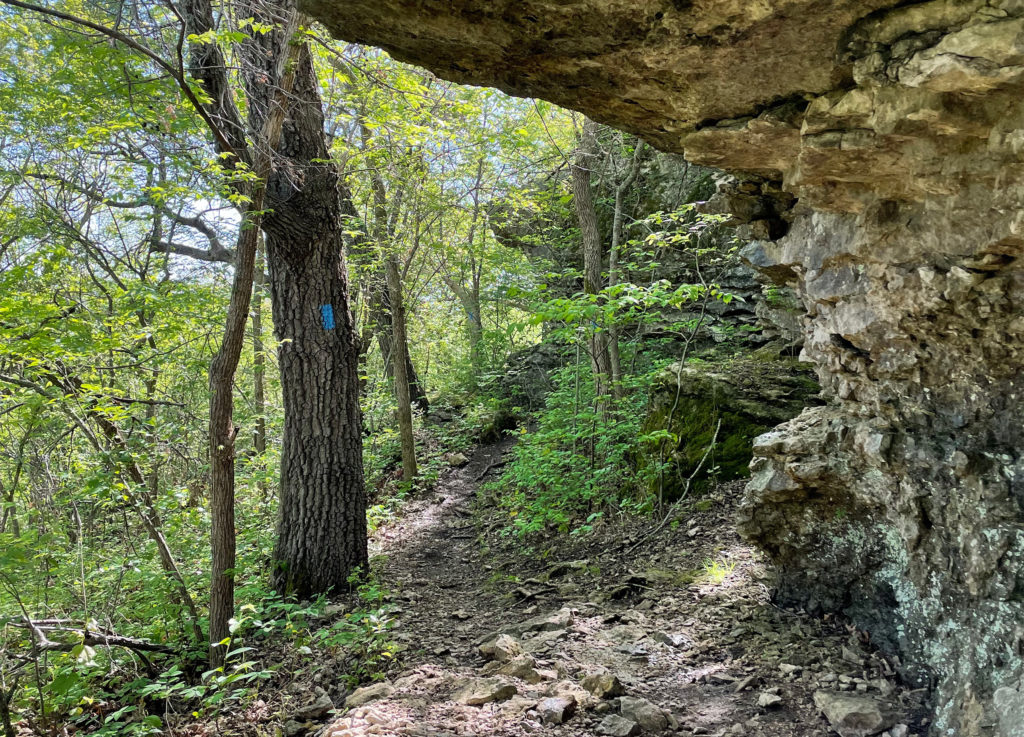At 9:15 am on a sunny Saturday morning, the single strands of spider web still hang across the eastern trailhead of Elk River Hiking Trail. In the gravel parking lot, two jeeps are parked, and there’s not a soul to be seen.
Elk River has a reputation as the most rugged hiking trail in Kansas. From the eastern trailhead at the corner of two numbered county roads, you’ll hop onto a rusty plank to cross a stream before you’re out of sight of your car.
The trail is rocky, muddy, steep and long—it’s fifteen miles between the trailheads, which is why most hikers aiming to tackle the whole thing leave a car on each side. If you’re used to hiking around KC, where trails tend to be flat and are often built to be ADA accessible, then Elk River may catch you off guard.

This trail is just a few miles north of the homestead where Laura Ingalls Wilder found inspiration for Little House on the Prairie, but the landscape here is dominated by limestone bluffs instead of open grassland vistas. Most people who tackle the trail say the same thing: It doesn’t feel like Kansas, and there’s really nothing else like it in the Sunflower State.
The land that the Elk River trail is on is owned by the U.S. Army Corps of Engineers, but the trail itself is maintained by the Kansas Trails Council.
The trail is marked with blue blazes on trees and rocks, and its eastern side runs the rim of the Elk City Reservoir. The blazes are frequent, and if you find yourself off the track in the thick yellow cedar, it’s not hard to find your way back on. It can be backpacked, and you’re welcome to set up camp at any flat spot along the trail on the U.S. Army Corps of Engineers’ land, but it’s probably better thought of as a long point-to-point day hike with two cars given that, at times, it feels more like bushwhacking.
If you do backpack it, bring trekking poles and expect to use them. (Also worth mentioning: As of press time, the water line had just been repaired at the eastern trailhead—play it safe and bring at least four liters per person.)

Tabitha Westhoff, a support services specialist for the Corps’ Big Hill Lake office, which oversees the trail, did the entire trail last month and says that hikers should plan to spend the recommended eleven hours on the trail. If you don’t want to backpack but do want to get an early start and/or avoid a long drive back to KC after the hike, there are two campgrounds with basic amenities near the trailheads, at Outlet Channel and Card Creek. Both campgrounds are run by the Corps of Engineers, so sites are reservable at recreation.gov.
Chris Hammerschmidt, the Corps staffer who oversees the trail’s land, says that hikers should understand they’re going into a remote area. Backpackers should hang bear bags to keep raccoons out of their food, and day-hikers should be prepared for ticks, mosquitos, blisters and heat.
“There are probably two to three times a year people show up without enough water or wearing the wrong shoes and end up needing to be rescued,” he says. “We had a woman last year show up with one water bottle and it was ninety degrees out—she made it about halfway before calling because she needed help.”

While you’re there
The Elk River trail is just north of the Oklahoma border off U.S. 169, 2.5 hours south of KC. While you’re in the area, consider visiting the Little House on the Prairie Museum and grabbing some fried chicken in Pittsburg.
Little House, Long Story
Laura Ingalls Wilder only spent a year living on the open prairie outside Independence, Kansas, but the books inspired by that experience—her family was squatting on Native American land and had no legal right to be there—still resonate today. You can see the family’s homestead at the Little House on the Prairie Museum (2507 County Road 3000, Independence, KS. Hours vary, call 620-289-4238 for info) at a site discovered in 1969 which has been a museum since 1977. The museum includes a replica of the family cabin, plus a period-appropriate one-room schoolhouse and post office.
Which Chicken Are You Pickin’?
The mining town of Pittsburg is famous for its rival chicken joints, Chicken Mary’s and Chicken Annie’s, which are a few blocks apart on the north side of town. These days the rivalry is mainly between the original Mary’s (1133 E. 600th Ave., Pittsburg) and Pichler’s Chicken Annie’s on the south side (1271 S. 220th St., Pittsburg). Note that all of them open at 4 pm every day except Monday, when they’re closed, and Sunday, when they open for lunch. Mary’s, Annie’s and the other Annie’s all make basically the same lightly seasoned brand of bird (Mary’s batters with egg and milk while both Annie’s only use egg) and serve it with sides like tangy German-style slaw, green beans and chip-chopped fried onions.






